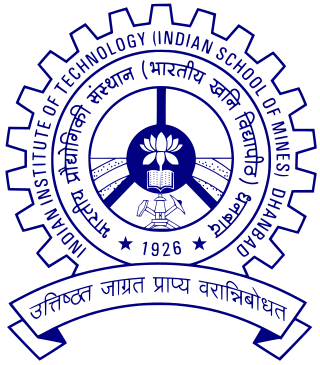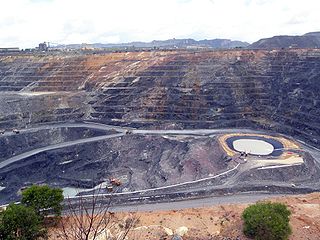
The General Mining Act of 1872 is a United States federal law that authorizes and governs prospecting and mining for economic minerals, such as gold, platinum, and silver, on federal public lands. This law, approved on May 10, 1872, codified the informal system of acquiring and protecting mining claims on public land, formed by prospectors in California and Nevada from the late 1840s through the 1860s, such as during the California Gold Rush. All citizens of the United States of America 18 years or older have the right under the 1872 mining law to locate a lode or placer (gravel) mining claim on federal lands open to mineral entry. These claims may be located once a discovery of a locatable mineral is made. Locatable minerals include but are not limited to platinum, gold, silver, copper, lead, zinc, uranium and tungsten.

Indian Institute of Technology Dhanbad is a public technical university located in Dhanbad, India. IIT Dhanbad is an Institute of National Importance, and is ranked among the premier engineering institutions of India.

Angul district; also known as Anugul, is one of the thirty districts of Odisha in eastern India. The city of Angul is the district headquarters of Angul district. A major industrial hub of the state, the district hosts numerous industries relating to coal, bauxite and steel apart from extensive forests including the Satkosia Tiger Reserve.

The Mineral Leasing Act of 1920 30 U.S.C. § 181 et seq. is a United States federal law that authorizes and governs leasing of public lands for developing deposits of coal, petroleum, natural gas and other hydrocarbons, in addition to phosphates, sodium, sulfur, and potassium in the United States. Previous to the act, these materials were subject to mining claims under the General Mining Act of 1872.
The mining industry in India is a major economic activity which contributes significantly to the economy of India. The gross domestic product (GDP) contribution of the mining industry varies from 2.2% to 2.5% only but going by the GDP of the total industrial sector, it contributes around 10% to 11%. Even mining done on small scale contributes 6% to the entire cost of mineral production. Indian mining industry provides job opportunities to around 700,000 individuals.

Bijoy Krishna Handique was an Indian politician who was a member of the 15th Lok Sabha of India. He represented the Jorhat constituency of Assam and was a member of the Indian National Congress (INC) political party. He was the only son of Krishna Kanta Handique, a renowned Indologist. Handique was a senior Member of Parliament from the North Eastern Region and represented the Jorhat Lok Sabha, Assam for six consecutive terms since 1991 to 2009. He also served as a Rajya Sabha member from 1980 to 1986. He had been elected to the Assam State Assembly in 1972 from the Jorhat constituency.
Title 30 of the United States Code outlines the role of mineral lands and mining in the United States Code.

The Ministry of Mines is the ministry in the Government of India. The ministry functions as the primary body for the formulation and administration of laws relating to mines in India. The head of the ministry is G. Kishan Reddy, who has been serving since June 2024.

Coal in India has been mined since 1774, and India is the second largest producer and consumer of coal after China, mining 777.31 million metric tons in FY 2022. Around 30% of coal is imported. Due to demand, supply mismatch and poor quality with high ash content, India imports coking coal to meet the shortage of domestic supply. Dhanbad, the largest coal producing city, has been called the coal capital of India. State-owned Coal India had a monopoly on coal mining between its nationalisation in 1973 and 2018.
Australian mining law governs the exploration and extraction of minerals and petroleum in Australia. It differs substantially from the mining laws of other common law countries, the most important differences arising from the policy decision that the Crown should own all minerals.

Radioactive ores were first extracted in South Australia at Radium Hill in 1906 and Mount Painter in 1911. 2,000 tons of ore were treated to recover radium for medical use. Several hundred kilograms of uranium were also produced for use in ceramic glazes.
Mining scams in India refers to a series of alleged widespread scams in various ore-rich states of India, which has generated controversy. Such issues span encroachment of forest areas, underpayment of government royalties, and conflict with tribals regarding land rights. The spill-over of the effects of legal mining into issues such as Naxalism and the distortion of the Indian political system by mixed politics and mining interests, has gained international attention.
Land acquisition is the power of the union or a state government in India to take private land for public, and to compensate the original owners and other persons affected due to such acquisition.
The coal allocation scam, dubbed in the media as Coalgate, is a major political scandal concerning the Indian government's allocation of the nation's coal deposits to public sector enterprise (PSEs) and private companies. In a draft report issued in March 2012, the Comptroller and Auditor General of India (CAG) office accused the Government of India of allocating coal blocks in an inefficient manner during the period 2004–2009. Over the summer of 2012, resulting in a Central Bureau of Investigation probe into whether the allocation of the coal blocks was in fact influenced by corruption.

The Essential Commodities Act (ECA) is an act of the Parliament of India that was established to ensure the delivery of certain commodities or products, the supply of which, if obstructed due to hoarding or black marketing, would affect the normal life of the people. This includes foodstuff, drugs, fuel etc. This act was modified by the Essential Commodities (Amendment) Act, 2020 as part of the 2020 Indian farm reforms.
The Andhra Pradesh Reorganisation Act of 2014, commonly known as the Telangana Act, is an Act of Indian Parliament that split the state of Andhra Pradesh into Telangana and the residuary Andhra Pradesh state, as an outcome of the Telangana movement. The Act defined the boundaries of the two states, determined how the assets and liabilities were to be divided, and laid out the status of Hyderabad as the permanent capital of new Telangana state and temporary capital of the Andhra Pradesh state.
Ordinances are laws that are promulgated by the President of India on the recommendation of the Union Cabinet, which will have the same effect as an Act of Parliament. They can only be issued when Parliament is not in session. They enable the Indian government to take immediate legislative action. Ordinances cease to operate either if Parliament does not approve of them within six weeks of reassembly, or if disapproving resolutions are passed by both Houses. It is also compulsory for a session of Parliament to be held within six months. A total of 679 ordinances have been issued from 1950-2014.

The mining industry of Uganda, documented as early as the 1920s, witnessed a boom in the 1950s with a record 30 percent of the country's exports. It received a further boost when mining revenues increased by 48 percent between 1995 and 1997. However, the World Bank reported that the sector's contribution to gross domestic product (GDP) dropped from 6 percent during the 1970s to below 0.5 percent in 2010. Uganda's extractive industry activities have been identified by the Natural Resource Governance Institute as focused on "extraction of cobalt, gold, copper, iron ore, tungsten, steel, tin and other industrial products such as cement, diamonds, salt and vermiculite". Limestone is sold in local markets whereas gold, tin, and tungsten are major exports.

The Foreign Contribution (regulation) Act, 2010 is an act of the Parliament of India, by the 42nd Act of 2010. It is a consolidating act whose scope is to regulate the acceptance and utilisation of foreign contribution or foreign hospitality by certain individuals or associations or companies and to prohibit acceptance and utilisation of foreign contribution or foreign hospitality for any activities detrimental to the national interest and for matters connected therewith or incidental thereto. It is designed to correct shortfalls in the predecessor act of 1976. The bill received presidential assent on 26 September 2010.

The Meghalaya Legislative Assembly election was held on 27 February 2018 to elect 59 of 60 members to the Meghalaya Legislative Assembly, with the results declared on 3 March. The scheduled election in Williamnagar constituency was delayed to an undetermined date following the death of Nationalist Congress Party candidate Jonathone Sangma in an IED blast in East Garo Hills district on 18 February 2018. The incumbent Indian National Congress government, led by Chief Minister Mukul Sangma, attempted to win re-election for the third consecutive time.










